Air conditioning is a process that is used to create and maintain certain temperatures, relative humidity, and air purity conditions in indoor spaces. The Air conditioning system is used to maintain a level of personal comfort.
Air Conditioning Systems are small units that will cool a certain amount of area that is not too big, like a single room in a house. Air Handling Units (AHUs) are vast units that have a large capacity. The air conditioners come in various specifications and sizes.
Basic principle of air conditioning systems
There are two sets of metal coils. The first one will collect the heat from the surroundings and the second coil will disperse the heat outside. The main part is the refrigerant. It is a liquid mixture that transfers heat between two coils.
Based on this, air conditioners are of two types. They are:
- Stand-Alone AC Units
- Split-System AC Units
Stand-Alone AC Units
In the stand-alone type AC units, both coils are in one device. A stand-alone AC unit is usually located inside the house.
Features of Stand-alone Air Conditioners:
- Stand-alone Air Conditioners are easy to install and move around.
- Stand-alone Air Conditioners are cheaper to buy.
- Stand-alone Air Conditioners can be noisier (the compressor is located inside the house)
- Stand-alone Air Conditioners have lower capacity as compared to split AC systems
- Stand-alone Air Conditioners need an air vent that needs to go out of the window or sliding door.
Stand-alone Air Conditioners are of five different types:
1. Portable Air Conditioning System
Portable air conditioners are the most popular units for domestic use. They have wheels at the bottom which make it easier to move them anywhere. Portable air conditioners are handy for people who use many rooms in their houses. Portable air conditioners will take in the warm air from the room and cool it.
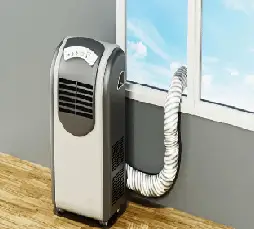
The cool air is then circulated in the room. The hot air is vented out through an air hose (air pipe). Portable air conditioners are compact in size. The only disadvantage is that every time the AC is moved, the air pipe should also be moved. The air hose is generally kept outside the window or sliding door.
There are two types of Portable air conditioners.
1a. Single Hose Air Conditioning System
In a single hose, the air hose is used just to exhaust the hot air outside. Hence, only the indoor air is collected, cooled, and released in the room again. No outside air is taken.
1b. Double Hose Air Conditioning System
In a double hose, there are two vents. One vent is used to exhaust the hot air outside and the second is used to pull fresh air from outside. So, along with the indoor air, air from outside is also used for cooling. This will reduce the load on the air conditioner.
2. Window Air Conditioning System
In the window air conditioners, the AC unit is inserted between the windows. The basic components of the refrigeration cycle, evaporator coil, refrigerant gas, condenser coil, compressor, and fan are present in a single unit.
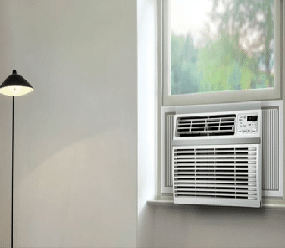
The cooling unit is placed inside the window and the exhaust unit is outside the window. The maintenance of these air conditioners is easier as they are placed between the windows. Window air conditioners do not take up any floor space. Window air conditioners are noisy when operated.
3. Ducted Air Conditioning System
In huge buildings, it is not feasible to install a single air conditioning unit in each room because it will make the room clumsy and bulky. Central air conditioners are used in such cases.
In ducted air conditioning systems, the whole AC unit is placed on the building’s rooftop or terrace. The central air conditioners have vents and holes in different areas of the building. These holes are usually in the walls or ceilings. These supply ducts are the location from where cool air enters the rooms. It works by circulating cool air through their supply and return ducts.
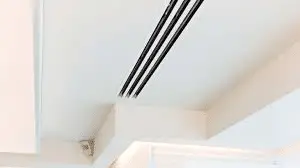
It cools all the rooms in one go. After starting the big AC units, the whole building eventually cools. The greatest advantage is that it does not create any noise while being operated (because there is no unit). Humidity is also controlled to a great extent. Because of the large units of high power, the energy bills are more. It is difficult to trace the exact duct in case of failure. Duct leakage can also reduce efficiency.
4. Wall Mounted Air Conditioning System
Wall Mounted Air Conditioning Systems are similar to ducted air conditioners, but they can cool a single room only. The Wall Mounted Air Conditioning Systems are ductless and are mounted on the walls. This type of Air Conditioning System is the most popular air conditioning system for domestic use.
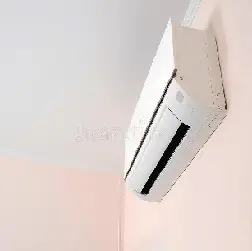
Wall Mounted Air Conditioning systems are cheaper as compared to ducted ACs. Efficiency is higher as compared to a window or portable AC. Wall Mounted Air Conditioning Systems are smart and provide a variety of temperature and humidity control.
5. Floor Mounted Air Conditioning System
Floor Mounted Air Conditioning Systems are similar to wall-mounted air conditioners. The only difference is that Floor Mounted Air Conditioning systems are mounted on the floor instead of the wall.
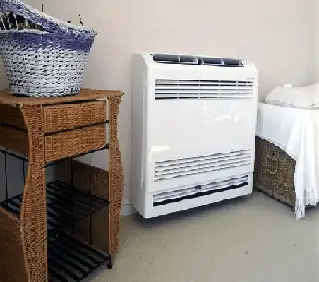
A lot of space is needed for Floor Mounted Air Conditioning System air conditioners.
Split-System AC Units
The split air conditioning system has two shells. Inside the home, there is a small shell and outside the house is the bulkier noisy shell. This means, the cooling coil is inside the house and the heating coil and compressor are outside the house. These are commonly found in homes and offices.
Advantages of split-system AC units
- Split-system AC units do not make noise (as the compressor is outside).
- Split-system AC units have a large capacity and cool the house quickly.
- The inner shell is usually smaller and looks better.
- Air vents are not needed.
Limitations of split-system AC units
- Split-system AC units are expensive.
- The outside unit needs to be installed somewhere near the house.
Split-system AC units are also available in several types like central air conditioners, wall-mounted and floor-mounted, Ceiling types, and mini split types.
Other types of air conditioners
1. SMART Air Conditioners
SMART Air conditioner is an extension of wall-mounted or floor-mounted ACs. These can be accessed by mobiles. They are connected to Wi-Fi and are IoT-enabled. They have a wide variety of options and control that increase their efficiency and productivity.
2. Geothermal Air Conditioners
Geothermal HVAC is related to geothermal heating, cooling, and ventilation. They use energy stored in the ground to heat and cool. It is environment friendly as it uses renewable geothermal energy and the insulating properties of Earth.